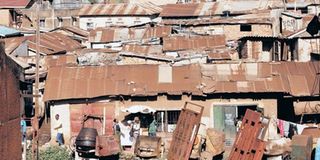Answer to slum problem ‘lies in flats’

Some houses in Nairobi can host over 1,000 people on only a quarter-acre plot. FILE PHOTO |
What you need to know:
- Some houses in this Nairobi suburb can host over 1,000 people on only a quarter-acre plot, so how many of such flats would we need to rid Nairobi of slums? The city has a population of three million people by night. Of these, 60 per cent live in slums and informal settlements. This totals to about 1.8 million people, thus when divided by the 1,000 people, we would need 1,800 flats
Kenya, and especially Nairobi County, has been grappling with the issue of providing adequate and decent shelter for the growing number of urbanised Kenyans, especially the low-wage earners who live in informal settlements.
Numerous projects, such as slum upgradings, have been initiated by the government to end this problem, but the outcome has been far from the rosy picture envisaged.
The government has also, on many occasions, urged the private sector to provide support in making available decent housing to this segment — and even offered incentives — but the enthusiasm has been underwhelming.
One man who has been following this keenly is Kariuki Waweru, the director at Arkade Africa Real Estate, and he thinks the solution has been staring us in the eye for decades.
“I have always heard of a place in Nairobi’s Eastlands known as Lucky Summer, where some developers have put up numerous high-rise flats,” he says. “I thought these flats were like the rest that line of estates in Nairobi... until I went to value one of them and was pleasantly surprised.”
History has it that the land on which the growing Lucky Summer neighbourhood stands was initially bought by a group of farmers going by the same name some years ago. Due to the ambitious nature of these farmers — who hailed from Githunguri in Kiambu County — and the demand for low-income housing, most of them ignored Nairobi City Council by-laws and planning regulations to build more floors than had been gazetted.
“The seven- to nine-floor flats stand on the Lucky Summer land as a statement that this group of farmers is meeting a real need for Nairobi’s ever-growing population,” says Waweru.
SUB DIVIDED
The land in this area is divided into small plots, some as tiny as an eighth of an acre and others slightly bigger, but this has not stopped the investors from squeezing as many units on these small parcels as they can, he says.
Of course these types of haphazard developments have been accused of putting a lot of strain on existing infrastructure, while their designs often leave a bad taste in the mouth.
But, as Waweru puts it, they are better than slums. All that slum dwellers wish for is housing that affords them some sense of dignity, no matter how feeble.
One of the flats, which we will christen Flat A, has a total of about 280 single rooms on nine levels, all squeezed on a quarter-acre plot. Assuming that each single room has two parents and two children, this flat hosts over 1,100 people every night. The rent for each unit is Sh3,500 a month, thus the total rent that this investor gets in a month is Sh980,000.
“If the cost of water, electricity, and emptying the septic tank twice a week is deducted, the investor is left with about Sh800,000 a month in net income. The net rent per year thus adds up to Sh9.6 million,” says Waweru.
Going by the cost of a quarter acre of land at Lucky Summer now — about Sh12 million — and since the cost of putting up such a flat is estimated at about Sh200,000 per single room, which would add up to Sh56 million, then the total cost of this development would be Sh68 million, says Waweru.
The payback period for investors would be seven years, which would be obtained from the total cost of development (Sh68 million) divided by the annual net rent of Sh9.6 million.
“This is very good, considering that most real estate investments’ payback period is between 12 and 15 years,” says Waweru.
If the above case study can host over 1,000 people on only a quarter-acre plot, how many of such flats would we need to rid Nairobi of slums?
Nairobi has a population of three million people by night. Of these, 60 per cent live in slums and informal settlements.
This totals to about 1.8 million people. When divided by 1,000 people, we would need 1,800 flats. “Yes, we would need only 1,800 such flats and everyone in Nairobi will have a decent roof over their heads,” says Waweru.




